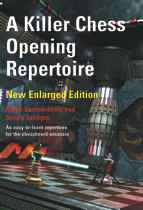Killer Chess Opening Repertoire, A
Aaron Summerscale, Sverre Johnsen

A Killer Chess Opening Repertoire by GM Aaron Summerscale was first published in 1998 by Everyman Chess. This second, enlarged edition was updated by Norwegian Sverre Johnsen, author of previous works for Gambit on the London System, Ruy Lopez and the Stonewall Dutch.
The proposed repertoire has stayed pretty much the same. Aimed at club players up 2200, A Killer Chess Opening Repertoire offers a set of openings based on quick development and attacking play with the English GM Mark Hebden as the role model.
Summerscale explains his motivation for writing the book in the introduction:
“The aim of this book is to provide a complete repertoire for the boy I used to be. The variations chosen are a little offbeat, but they fit together very nicely. The three main systems, the Barry Attack, the 150 Attack and the Colle-Zuckertort, can be used against virtually any defense Black plays against 1.d4. These contain the meat and bones of the book, and once mastered, will provide a complete repertoire for White against most defenses.
The lines covered are:
1 Barry Attack (1.d4 Nf6 2.Nf3 g6 3.Nc3)
2 150 Attack (1.d4 Nf6 2.Nf3 g6 3.Nc3 Bg7 4.e4 d6 5.Be3)
3 Colle-Zukertort System (1.d4 Nf6 2.Nf3 e6 3.e3 d5)
4 1.d4 d5 2.Nf3: Beating the Anti-Colle Systems
5 Classical Queens Indian (1.d4 Nf6 2.Nf3 e6 3.e3)
6 Anti-Benoni 137 (1.d4 Nf6 2.Nf3 c5 3.d5)
7 Anti-Dutch 2 Bg5 (1.d4 f5 2.Bg5)
8 Odds and Ends (1.d4 b5; 1.d4 h6)
Johnsen has chosen to build on the first edition, addressing the areas where theory has substantially changed or Summerscaless original coverage needed expanding. There are seven new model games (68 overall) which strike a good balance between explanatory prose and concrete variations. The present edition is approximately 50 pages longer than the first but the reader gets more than this as the Gambit format uses a slightly smaller font style than the original. All the analysis has been blunder-checked by Rybka 3.
Arguably the most important new material appears in game 46 (Meister-Seuffert, Germany 2007/8.) in the chapter on the Classical Queens Indian. There after 1.d4 Nf6 2 Nf3 e6 3 e3 b6 4 Bd3 Bb7 5 0-0 c5 6 c4 Be7 7 Nc3 cxd4 8.exd4 d5 9.cxd5 Nxd5 10.Ne5 0-0 11.Qh5 Nf6 12.Qh4 Ne4 13.Qh3 Qxd4 now 14.Bf4 and not 14.Nxf7 is given center stage. Johnsen believes that after 14…Nf6 15.Ne2 Qa4 16.Bg5 (the first edition offered only 16.b3 of Lobron-Khalifman, Groningen 1993) White is doing well.
The Barry and its cousin the 150 attack (the number 150 referring to the English rating which translates to 1800 Elo) work together seamlessly, but elsewhere the connections are not so smooth. The backbone of the repertoire against non-Kings Indian/Gruenfeld setups is 1.d4, 2.Nf3, 3.e3, 4.Bd3 followed by kingside castling, Nbd2 and a queenside fianchetto what one would associate more with Zuckertort (or in modern times Yusupov) rather than Colle.
The Zuckertort tends not to do to well against lines where Black has not played …e6 and can still develop his queen bishop to f5 or g4. Here A Killer Chess Opening Repertoire proposes to transpose into the Slav/Semi-Slav with 1.d4 Nf6 2.Nf3 d5 3.e3 Bf5/Bg4 4.c4. Against 3…c5 a reversed Queens Gambit Accepted with 4.dxc5 is offered.
Another variation where it is necessary to change the original script is 1.d4 Nf6 2.Nf3 c5 where White does not have a real alternative to 3.d5. Likewise adjustments have to be made to the anti-Dutch line 1.d4 f5 2.Bg5 when White tries 1.d4 e6 2.Nf3 f5 by 3.d5!?.
All in all A Killer Chess Opening Repertoire offers a nice mix for the player who doesnt like to study theory too much but still wants a chance to come out of the opening with chances for an advantage. The proposed repertoire also offers a variety of middle game pawn structures (for and against the isolated queen pawn, hanging pawns, Benoni structures, etc.) that promise to keep things fresh.
Recommended
